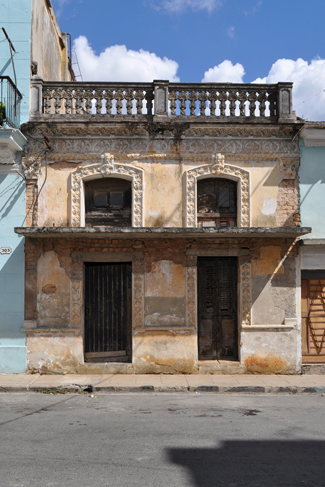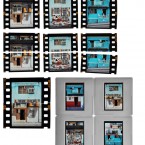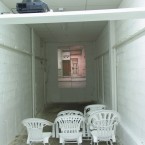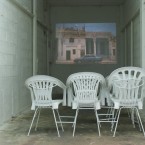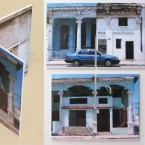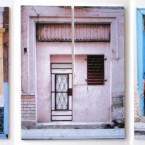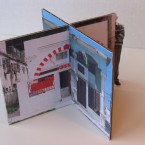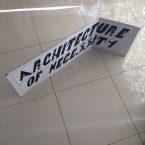Arquitectura de la Necesidad/ Architecture of Necessity (1997 – present)
Cuando la casa deviene su propio diagrama / when the house becomes itself-diagram.
Arquitectura de la Necesidad es un concepto con una doble función. Opera inicialmente como un término descriptivo y austero en su valor retórico que apunta a una arquitectura de la urgencia y la precariedad. Su segunda y más importante función es metafórica: enuncia una arquitectura que es su propio diagrama. La casa deviene una estructura que relaciona, un modelo físico que asocia al individuo y sus necesidades con los materiales, las tecnologías, los límites y posibilidades legales y económicas. Desde esta perspectiva la imagen Arquitectura de la Necesidad deviene estructural y programática.
He asociado estas construcciones vernáculas con las producciones naturales conocidas como estalactitas y estalagmitas, donde la forma es el resultado del movimiento fluido de los materiales atraídos por la fuerza de gravedad. En esta arquitectura el movimiento irreprimible de los materiales forma también un tejido de líneas y vacíos, una superposición de capas y estructuras, que como en los procesos naturales de sedimentación, se apoyan unas sobre otras. Este movimiento fluido responde a una fuerza tan poderosa e inevitable como la gravedad: la fuerza de la Necesidad.
Architecture of necessity is a term with two functions. On the one hand, as the trope to enunciate a building that is shaped by the urgency and precariousness. And on the other hand, as a metaphor that refers to a structure, to a scheme that puts human needs in relation to the legal limits and possibilities, intellectual and materials resources. Under this concept the house becomes a diagram of itself, and this image becomes structural and programmatic.
Since necessity plays a central role in the generation and regulation of this kind of architecture, I associate it with natural forms known as stalactites and stalagmites, where the shape is the result of a fluid movement of materials attracted by gravitational force. In this popular architecture, the irrepressible movement of materials also produces a grid of lines and holes, a superimposition of layers and structures that, just as in the natural process of sedimentation, are supported one over the other. This fluid movement responds to a strength as powerful and unavoidable as gravity, the force of necessity.
- Architecture of Necessity. Moral Modulor
- Architecture of Necessity. Moral Modulor
- Architecture of Necessity. Moral Modulor 1997-2012
- Architecture of Necessity. Moral Modulor 1997-2012
Moral Modulor (from Architecture of Necessity) are two collections of 80 slides each one of facades of Cuban houses transformed by their inhabitants: Moral Modulor I (from Architecture of Necessity: 1997-2008). 80 slides and cut, 2008; and Moral Modulor II (from Architecture of Necessity: 2012 -2013). 80 slides and cut, 2013.
I cut the slides in two or three parts and I assembled them again but changing the order of the parts and changing them, also, of image.
Moral Modulor:
“Le Corbusier synthesized in his “Modulor” the human traditions that have attempted to project the physical and spiritual dimensions of the universe through architectural forms.
“The exterior is always and interior,” Le Corbusier said, speaking of other things.
The modified architecture of Havana is driven by an unavoidable fate: Necessity. The city’s inhabitants are aware of their real needs. Their prejudices stripped by the inevitable, they transform their city under a new order: The Moral Modulor.
Le Corbusier proposed: “By imposing the order of his foot or his arm, he has created a unit which regulates the whole work; and this work is on his own scale, to his own proportions, comfortable for him, to his measure. It is on a human scale. It is in harmony with him: that is the true main point.”*
The Moral Modulor, unlike the “Corbusierean” Modulor, is a human being at the same time as a measuring tool. He embodies the human potential to understand urgency and inscribe it in space. He adds, to the order established by human dimensions, the moral dimension that necessity recovers.
Urgency provides for the individual a foundational alibi. Every sexual or physiological impulse, every birth and even death, will provoke the appearance of new walls, columns, stairways, new windows or plumbing and electrical systems.
Form follows Necessity.
The modified houses of Havana express this relationship.
It’s an Architecture of Necessity.”
Ernesto Oroza from For an Architecture of Necessity and Disobedience, 2006.
- Architecture of necessity (#inherentdisplay) 2007
- Architecture of necessity (diagrams) 2007
- Architecture of necessity (diagrams) 2007
- Architecture of necessity (diagrams) 2007
